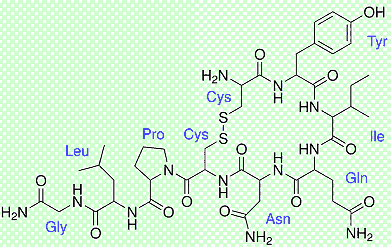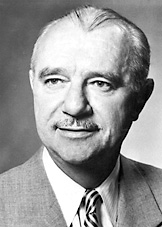![]()
Oxytocin
The molecule involved in pregnancy,
breastfeeding and sexual fidelity!
![]()
Simon Cotton
Uppingham School, Rutland, UK
![]()
Molecule of the Month January 2009
Also available: JSMol version.
![]()

|
OxytocinThe molecule involved in pregnancy,
|
 |
 Tabloid headlines?
Tabloid headlines?No, the World number 1 Science journal, Nature.
 It is, but there is a lot more to it than that. In humans, oxytocin is produced in the hypothalmus; it is released from the posterior pituitary gland. There are receptors in many parts of the brain, as well as elsewhere in the body, such as the reproductive system. In lactating mothers who are breastfeeding, oxytocin causes milk to be released in the breasts, so that the infant can feed at the mother's nipple. Oxytocin is also responsible for the dilation of the cervix during birth, and for contractions during labour; its name derives from "quick birth" in Greek, and certainly beats calling it 3-(19-amino-13-sec-butyl-7-(carboxymethyl)-4-(2-(1-(carboxymethylamino)-5- guanidino-1-oxopentan-2-ylcarbamoyl) pyrrolidine-1-carbonyl)-16-(4-hydroxybenzyl)-6,9,12,15,18-pentaoxo-1,2-dithia-5,8,11,14,17-pentaazacycloicosan-10-yl)propanoic acid!
It is, but there is a lot more to it than that. In humans, oxytocin is produced in the hypothalmus; it is released from the posterior pituitary gland. There are receptors in many parts of the brain, as well as elsewhere in the body, such as the reproductive system. In lactating mothers who are breastfeeding, oxytocin causes milk to be released in the breasts, so that the infant can feed at the mother's nipple. Oxytocin is also responsible for the dilation of the cervix during birth, and for contractions during labour; its name derives from "quick birth" in Greek, and certainly beats calling it 3-(19-amino-13-sec-butyl-7-(carboxymethyl)-4-(2-(1-(carboxymethylamino)-5- guanidino-1-oxopentan-2-ylcarbamoyl) pyrrolidine-1-carbonyl)-16-(4-hydroxybenzyl)-6,9,12,15,18-pentaoxo-1,2-dithia-5,8,11,14,17-pentaazacycloicosan-10-yl)propanoic acid!
It has been used in maternity wards as the drug Pitocin®, where it has been given to heavily pregnant women to induce labour. This is not as effective as natural release of oxytocin. It has now been found to have a role in the male reproductive system, being synthesised in the male testis, epididymis and prostate.
 Who discovered it?
Who discovered it?Oxytocin was discovered by a British pharmacologist named Henry Dale in 1909. It was first synthesised in 1953 by Vincent de Vigneaud (photo, left), an American chemist who was awarded the 1955 Nobel Prize for Chemistry for this discovery, the first polypeptide hormone to be synthesised. He also synthesised the related hormone vasopressin, which controls the body's retention of water. Oxytocin is cys-tyr-ile-gln-asn-cys-pro-leu-glu, vasopressin is cys-tyr-phe-gln-asn-cys-pro-arg-glu.
 Is that all that oxytocin does?
Is that all that oxytocin does?Human studies suggest that oxytocin levels are elevated by massage and by close intimacy, whether cuddling or by intercourse. Oxytocin is implicated in the mother-baby relationships, and in the very action of falling in love. You might say that it adds a whole new meaning to the phrase "chemical bonding".
Scientists have been investigating the prairie vole (Microtus ochrogaster, photo, below) for well over 20 years. Like humans, it is one of the 3% of mammals that form lifelong monogamous partnerships, and share tasks like raising their offspring. They also have exciting sex lives.
Researchers were struck by the differences between the prairie vole and its close relatives, the montane vole (Microtus montanus) and the meadow vole (Microtus pennsylvanicus), with the leading research being carries out by C. Sue Carter, now a Professor of Psychiatry at the University of Chicago. Though they are genetically extremely similar, the other voles do not form monogamous relationships, and the male does not take on a parenting role. In short, scientists asked "Why do voles fall in love?".
 Female prairie voles have many oxytocin receptors in their brains, whilst males have similarly many receptors for both oxytocin and vasopressin. There are a lot fewer in the montane vole. Blocking these receptors in prairie voles prevents them from forming their usual pair bonds, whilst introducing the vasopressin receptor gene into male meadow voles made them monogamous (though the role of a single gene in this is disputed).
Female prairie voles have many oxytocin receptors in their brains, whilst males have similarly many receptors for both oxytocin and vasopressin. There are a lot fewer in the montane vole. Blocking these receptors in prairie voles prevents them from forming their usual pair bonds, whilst introducing the vasopressin receptor gene into male meadow voles made them monogamous (though the role of a single gene in this is disputed).
It began to look as if oxytocin was implicit in sexual fidelity, and that prairie voles were a model for human love, but paternity tests on prairie voles found that up to a quarter of the litters had not been fathered by the life partner. So they are socially monogamous but not genetically monogamous. As Professor Ophir and his co-researchers at the University of Florida commented "Somewhat ironically, this distinction between prairie voles and other monogamous rodents, the dissociation of social and sexual fidelity, leads us to suggest that prairie voles are even better models of human attachment than has been appreciated".
 That's it for oxytocin, then?
That's it for oxytocin, then?Because oxytocin reduces fear and promotes trust, scientists have studied people playing "investment games", in which subjects were asked to give money to a trustee to invest on their behalf. Subjects who had inhaled oxytocin from a nasal spray were found to show greater levels of trust than control groups; indeed subjects whose trust had been abused in the game were able to "forgive and forget" if they had received oxytocin. Scientists now think that oxytocin might be able to help people with autism and sufferers from shyness.
![]()
![]()
![]() Back to Molecule of the Month page. [DOI:10.6084/m9.figshare.5249488]
Back to Molecule of the Month page. [DOI:10.6084/m9.figshare.5249488]